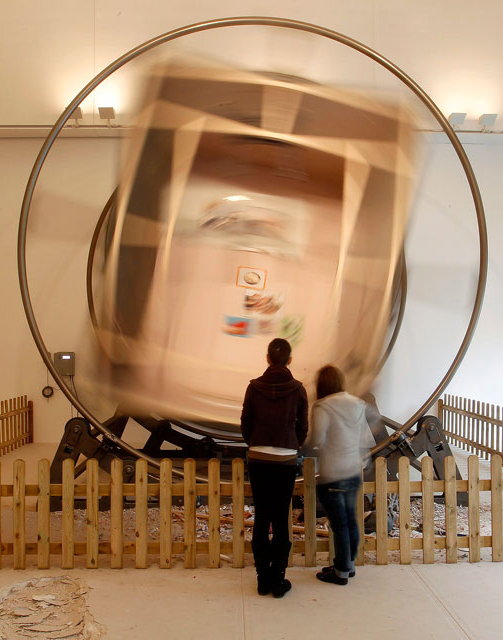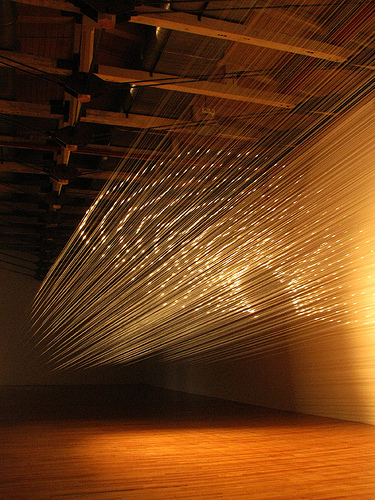


Arcangelo Sassolino
The way we were
Not only does Arcangelo Sassolino transform failure into art, but he manages to make the art of failing a profound part of the art of living. He goes even further in the awareness of risk. He is aware that his experiments may not hold up to the forces that he himself puts in place but this possible collateral damage wants to represent an additional value, becoming precisely the existential metaphor of the concepts of risk and failure. His installations explore the behavior and mechanical limits of matter, he forces their characteristics to distort their shape, gravity, pressure, friction, statics, and of each possibility Sassolino contemplates the risks of collapse with its precise timing and programming.

Pangenerator
Hash2ash
Installation touches on the themes of selfie-culture, and the fear of permanently losing the digital records of our lives due to technical failures, impermanence of data storage, or simply because of the obsolescence of the old digital file formats. Even with such compulsive overproduction of the images of ourselves we might end up with nothing but the blank memories of our past. Even the data on ourselves will eventually fade away… The installation consist of the display that prompts you to take a selfie on your phone, which it renders in digital particles on its large 1×1 meter screen. Then a moment later, your face scatters and falls apart and the real black gravel starts to fall at the bottom of the screen in perfect synchrony with the digital simulation. Gradually a dark mound builds up at the foot of the construction.

Chris Burden
כריס ברדן
КРИС БЕРДЕН
Ode to Santos Dumont
Ode to Santos Dumont pays homage to ingenuity, optimism, and the persistence of experimentation, failure, and innovation. Inspired by Brazilian-born pioneer aviator Alberto Santos-Dumont, widely considered the father of aviation in France, the kinetic airship sculpture was recently completed after a decade of research and work by Burden.

RUAIRI GLYNN
루아리 글린
Performative Ecologies
Each one of the four crude and very technically appearing devices is fitted with a punctually attached, luminous rod of fibreglass, which moves back and forth arrhythmically and freely. This installation’s poetry lies in the choreography of the little robots. They continuously try to gain the observers attention and impress him by waving their luminous tails. They recognise the reactions and movements of their human audience, learn from failure and share their experience with their robotic neighbours – a social structure of humans and machines.
.

Hansje van Halem
w for w
Hansje van Halem has run her studio in Amsterdam since 2003. In between deadlines for book designs, she fills time gaps with type drawings and empty book space with patterns. With a “practice makes perfect” mind-set, she taught herself not to be afraid of failure. Her time gaps soon took the upper hand and became her core business. While working on commissions from patterns for endpapers, architectural typography, and all scales in between, she creates a lot of overproduction.

lera auerbach
ICARUS
The National Youth Orchestra of Great Britain
conducted by Mark Wigglesworth
“What makes this myth so touching is Icarus’s impatience of the heart, his wish to reach the unreachable, the intensity of the ecstatic brevity of his flight and inevitability of his fall. If Icarus were to fly safely – there would be no myth. His tragic death is beautiful. It also poses the question – from Deadalus‘ point of view – how can one distinguish success from failure? Deadalus‘ greatest invention, the wings which allowed a man to fly, was his greatest failure as they caused the death of his son. Deadalus was brilliant, his wings were perfect, but he was also a blind father who did not truly understand his child.” LERA AUERBACH

Martin Kersels
Tumble Room
Mr. Kersels was born in Los Angeles and attended UCLA for both his undergraduate and graduate educations, receiving a BA in art in 1984 and an MFA in 1995. His body of work ranges from the collaborative performances with the group SHRIMPS (1984-1993) to large-scale sculptures such as Tumble Room (2001). His interest in machines, entropy, sound, and dissolution has produced work that examines the dynamic tension between failure and success, the individual and the group, and the thin line between humor and misfortune.

Tobias Putrih
Re-projection: Hoosac
Influenced by the utopian projects — and notable failures — of innovative artists and designers such as Buckminster Fuller, Frederick Kiesler, and Charles Eames, Tobias Putrih likens his works to experiments, or design prototypes. His use of cheap materials, including egg crates, cardboard, and plywood signify both a sense of potential and impending collapse. Many of the artist’s works reference the architecture and spectacle of the cinema: a space suspended between fantasy and reality, image and environment. With Re-projection: Hoosac Putrih distills the cinema to its most basic element: fishing line stretched across the gallery mimics the conical trajectory of a beam of light. A spotlight hits the strands of monofilament which in turn become a screen, reflecting an image in illuminated dots. Inspired by the Hoosac Tunnel just east of North Adams — a storied, engineering marvel that draws ghost-hunters to the area — Putrih’s tunnel is, likewise, both real and a representation, an optical trick that invites both wonder and investigation.

kenin cooley
launch failure